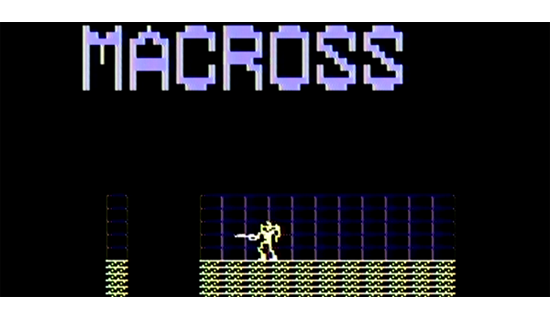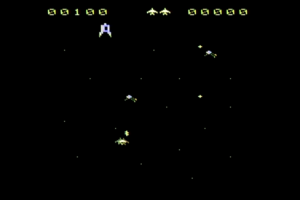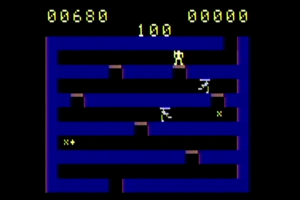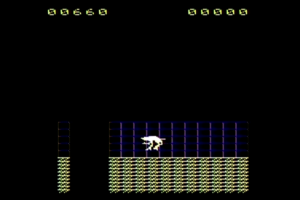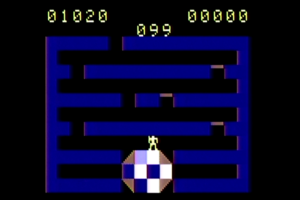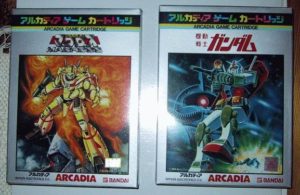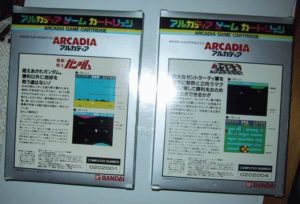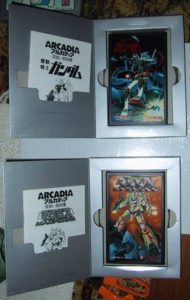The very first Macross home console game appeared on the short-lived Bandai Arcadia, the Japanese variant of Emerson’s Arcadia 2001 console that was released in the Japanese market by Bandai. This game is believed to have been released in May 1983 at a retail price of 3800 yen, though no official data seems to exist to support this. This was likely released around the same time as the Arcadia Gundam game, and while Gundam had been popular for a longer period of time (the TV series had begun airing in 1979), this was probably the ideal time for a Macross game since the first TV series was just about to wrap up. And though neither title was a particular impressive one, this Macross title may have come out on top.
As you might expect from a game that involves space ships of sorts, this is an early shooter. Unlike its Gundam counterpart though, it’s a three screen game (though the last two are mostly the same) that at first blush takes after its most immediate ancestor: Space Invaders. On this first screen you can move as far up and down the screen as you like using the joystick at the bottom of the Arcadia’s large Intellivision-like controller. However you can only shoot upward at the Zentradi fighters that descend upon you from Britai Kridanik’s battle ship, using either of the buttons found on the side of said controller. These slight tweak in the ways that you maneuver your ship leave Macross’ first screen feeling much more like a slightly modified and speedier Space Invaders.
At a certain point (most likely triggered either by score or amount of Zentradi fighters destroyed) Britai’s ship will begin to flash and opens up, allowing you to fly inside. You’re treated to a cinematic scene that’s quite rare for a game in 1983, in which you see your Valkyrie shift from Fighter mode, into Gerwalk mode (which only makes a brief appearance in this part of the scene), before finally going into Battroid mode where you’re now in control of a more Gundam-like robot holding a blaster (Don’t worry Macross fans, I know they’re different!).
On the second screen, things change up quite a bit. You’re now in control of a much more primitive version of the Battroid Valkyrie sprite, making your way through a small maze with an enemy in each passage. The red panels are doors that must be shot open to proceed, and these narrow passages don’t allow for any dodging of enemy bullets (which they tend to just shoot out at nothing) once they’re moving toward you. After making it to the bottom of the maze we go into the third screen, which isn’t very different from the second. This is a very similar maze but with a few less enemies, and the ship’s reactor at the bottom. Shoot this reactor three times, and a self-destruct timer begins to count down. If you don’t escape back out through the second screen (with all of the enemies now back) in time, it’s game over. If you do make it out in time, the screens loop and you get to start all over again! Before the timer begins, you’re treated to a primitive version of the Macross TV series self-titled opening theme song. After the timer it’s simply a generic siren sound effect.
Though it’s no masterpiece, Macross was certainly a higher quality Arcadia release than Gundam. It’s more likely that Macross was an original game, as opposed to the possibly re-skinned Gundam. Either way, it clearly had more care put into it. Just look at the transformation sequence that occurs on the title screen and in between the first and second screens! Someone really wanted that sprite to look like a Valkyrie, even if it didn’t particularly anywhere else in the game. There’s also just a tiny bit more variety and depth to the game play since it changes up considerably between screens (though the first Famicom entries for both of these series would swap as far as both variety and depth were concerned). Thanks to Kevin Bunch for letting me play this on original Leisure-Vision (the Canadian version of the Arcadia 2001) hardware!
(Footage of Kevin and I playing both the Gundam and Macross games for the Arcadia)
